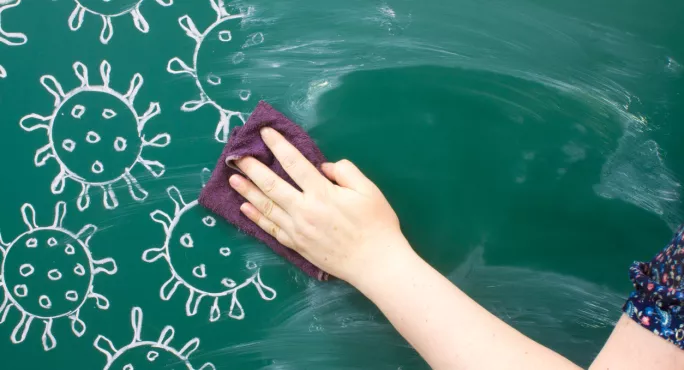Walking into a classroom is quite a different experience these days. Wash your hands, sanitise your hands, wipe down every surface, and definitely stay in your two-metre box.
Because, alongside all the retrieval practice, spaced practice, interleaving, knowledge-rich learning and personal development we are all so desperately trying to furnish our students with, we are also fighting an invisible battle. It is no longer the pen tapping, the notes passing or the chewing gum under the desk that are occupying our consciousness in a lesson, but the students themselves.
Over the past seven weeks, how many times has that innocent cough from the back row played on your mind? Is Josh in the middle row looking a bit flushed? Every sniffle followed by, “It’s OK, Miss, it’s not Covid.”
But how on Earth do we know? Every interaction we have is a possible transmission. Every child in our class is a potential carrier. The latest statistics tell us this: the rate of infection in 10- to 19-year-olds far surpasses that in every other age group. With asymptomatic cases prevalent, we are left feeling unsure and worried, and questioning everything.
Students: potential sources of coronavirus infection
With 30 pairs of eyes locked on you, every hour of the day, that also means 30 potential sources of infection. And, inevitably, this changes how we look at our students.
As teachers, our first priority is to teach, for our students to learn, to provide education about all that this world has to offer, and beyond. But we are all so much more than that. We are parents, children, siblings, friends. We are human.
So, for every potential source of infection, we then become vulnerable to taking it into the community, to our homes, to our families. It is this that adds the extra layer of complexity and concern to this profession. Another box filled with questions, another trail of thought to occupy our minds, right next to the planning, printing with enough time to quarantine the paper, and then waiting days upon days to mark an assessment…and then a few more days again before we can hand it back.
School leaders have worked tirelessly to ensure that we are safe, providing PPE, moving furniture, designing one-way systems and calculating risk after risk. But, despite all this, our students are human, too. They can become forgetful, stepping into your two-metre safe zone at the front of the room. Cue the teacher’s panicked response and instructions to “Move back! Move back!” as they recoil at the prospect of getting too close.
People are scared
We enter school every day with the knowledge that this could be the day that one of the 30 students (or hundreds of students in secondary schools) could prove these worries to be perfectly logical.
With one student coughing into the void, one student stepping into your safe zone, one student inadvertently brushing past you, it could cause a whole sequence of events that sees the world as you know it come crashing down. A bubble closed, colleagues instructed to self-isolate, an innocent coffee with your sister seeing her laid up in bed for weeks, wondering if her health will ever be the same again.
In spite of the Herculean efforts of school teams - from leaders to cleaners, caretakers to teachers and TAs - transmission is occurring in schools, rates are rising and people are scared.
These are legitimate worries, not the dramatic cries of an overtired teacher. It’s a real concern, with honest potential. It is unavoidable that the way we view our students has changed. They are no doubt looking at us differently, too.
Louise Lewis is a research lead and deputy head of science in a Yorkshire secondary school. She tweets @MissLLewis




